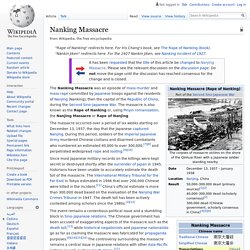

Nanking Massacre. The massacre occurred over a period of six weeks starting on December 13, 1937, the day that the Japanese captured Nanjing.

During this period, soldiers of the Imperial Japanese Army murdered Chinese civilians and disarmed combatants who numbered an estimated 40,000 to over 300,000,[7][8] and perpetrated widespread rape and looting.[9][10] Yemeni Revolution. The Yemeni Revolution,[17] initially named the Yemeni uprising (Intifada),[18] followed the initial stages of the Tunisian Revolution and occurred simultaneously with the Egyptian Revolution of 2011[19] and other Arab Spring protests in the Middle East and North Africa.

In its early phase, protests in Yemen were initially against unemployment, economic conditions[2] and corruption,[1] as well as against the government's proposals to modify Yemen's constitution. The protesters' demands then escalated to calls for the resignation of Yemeni President Ali Abdullah Saleh. Mass defections from the military, as well as from Saleh's government, effectively rendered much of the country outside of the government's control, and protesters vowed to defy its authority. Starting in late April, Saleh agreed to a Gulf Cooperation Council-brokered deal, only to back away hours before the scheduled signing three times. Iraqi insurgency (2011–14) The Iraqi insurgency, later referred to as the Iraq Crisis, escalated[14] after the withdrawal of U.S. troops in 2011, resulting in violent conflict with the central government, as well as sectarian violence among Iraq's religious groups.

The insurgency was a direct continuation following the U.S. -led invasion of Iraq in 2003. After the U.S. military's withdrawal, the level of violence rose,[15] as Sunni militant groups stepped up attacks targeting the country's majority Shia population to undermine confidence in the Shia-led government and its efforts to protect people without American backup.[16] Armed groups inside Iraq were increasingly galvanized by the Syrian Civil War, with which it merged in 2014.
[citation needed] Many Sunni factions stood against the Syrian government, which Shia groups moved to support, and numerous members of both sects also crossed the border to fight in Syria.[17] Wars of the Roses. The Wars of the Roses were a series of dynastic wars for the throne of England.

They were fought between supporters of two rival branches of the royal House of Plantagenet, the houses of Lancaster and York. They were fought in several sporadic episodes between 1455 and 1487, although there was related fighting before and after this period. Jallianwala Bagh massacre. The Jallianwala Bagh massacre, also known as the Amritsar massacre, was a seminal event in the British rule of India.

On 13 April 1919, a crowd of non-violent protesters, along with Baishakhi pilgrims, had gathered in the Jallianwala Bagh garden in Amritsar, Punjab to protest the arrest of two leaders despite a curfew which had been recently declared.[1] On the orders of Brigadier-General Reginald Dyer, the army fired on the crowd for ten minutes, directing their bullets largely towards the few open gates through which people were trying to run out. The dead numbered between 370 and 1,000, or possibly more. Hanoi Hilton. The Hanoi Hilton in a 1970 aerial surveillance photo.

Coordinates: The Hỏa Lò Prison was a prison used by the French colonists in Vietnam for political prisoners, and later by North Vietnam for prisoners of war during the Vietnam War when it was sarcastically known to American prisoners of war as the "Hanoi Hilton". French Foreign Legion. The French Foreign Legion (French: Légion étrangère (French pronunciation: [leʒjɔ̃ etʀɑ̃ʒɛʁ]), L.E.) is a military service wing of the French Army established in 1831, unique because it was exclusively created for foreign nationals willing to serve in the French Armed Forces.
Commanded by French officers, it is also open to French citizens, who amounted to 24% of the recruits as of 2007.[1] The Foreign Legion is today known as a unit whose training focuses not only on traditional military skills but also on its strong esprit de corps. As its men come from different countries with different cultures, this is a way to strengthen them enough to work as a team. Consequently, training is often described as not only physically challenging, but also very stressful psychologically.
History[edit] 2008 South Ossetia war. Russian and Ossetian forces battled Georgian forces throughout South Ossetia for four days, the heaviest fighting taking place in Tskhinvali.[21] On 9 August, Russian naval forces allegedly blockaded a part of the Georgian coast and landed marines on the Abkhaz coast.[51] The Georgian Navy attempted to intervene, but was defeated in a naval skirmish.[52] Russian and Abkhaz forces opened a second front by attacking the Kodori Gorge, held by Georgia.[53] Georgian forces put up only minimal resistance, and Russian forces subsequently raided military bases in western Georgia.

After the Georgian forces retreated, the Russians were able to enter uncontested Georgia and temporarily occupy the cities of Poti, Gori, Senaki, and Zugdidi.[21] Background[edit] Ethnic map of the Caucasus from 1995. Ossetians live in North and South Ossetia, as well as in central Georgia.